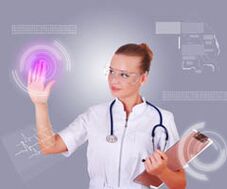
Translated from Greek, the word "chondroza" can be translated as "cartilage".However, as a rule, the word "osteochondrosis" does not mean any injury to the cartilage tissue (which would be logical), but only cartilage back diseases.
In patients with osteochondrosis, structure (and, therefore, function) of intervertebral discs - special cartilaginous structures, ensuring the movement and flexibility of the human spine.
As the disease progresses, irreversible changes also arise and develop in the vertebrae itself.
Causes of osteochondrosis
All the reasons why a person has a disease such as osteochondrosis, specialists are divided into endogenous (or internal) and exogenous (or, accordingly, external).
Endogenous causes are considered spinal disorders that were raised in a person in the abdomen, as well as age -related changes in cartilage and hereditary predisposition to osteochondrosis.
The main exogenous (external) expert experts consider the improper distribution of the load reaching the back.It is such a distribution that causes changes that occur with cartilage in those places where the greater excess pressure is.
Moreover, the causes of the development of osteochondrosis are spinal trauma and a variety of infections, strong and improper attitude, posterior muscles and lateral curvature of the spine.Moreover, the negative consequences for the spine may have weights of weights or prolonged stay in an unpleasant or unnatural position.
Despite popular belief, not only people of mental labor and those who do not follow their behavior can suffer (and suffer) osteochondrosis.This disease also torments those who are well prepared physically.For example, motorists, drivers and professional athletes.
In addition to the causes of purely mechanical property, problems with metabolism (for the most part, calcium and phosphorus), as well as a deficiency of trace elements and vitamins (in particular magnesium, manganese, zinc and vitamin D) can lead to the appearance and development of osteochondrosis.Many doctors are sure that a predisposition to osteochondrosis, inherited, also plays an important role in the onset of the disease.
Happens what happens with osteochondrosis?
When a person throws heavily, jumps or falls, he often sits in an unpleasant position, etc., intervertebral discs take microtrauma.If such injuries occur more or less often, over time, the discs lose their elasticity and flatten, and at the same time the distance between the vertebrae decreases.As a result, there is a crush of the nerve roots extending from the spinal cord.This is what causes back pain.At the same time, in the place where the nervous-vascular package is pushed, the edema is formed-as the result, the load on the same package increases, and the pain intensifies.
When the destruction of the intervertebral disc has already begun, it ceases to play the role of shock shock absorber, taking more and more injuries.Over time, a person's spine loses his natural flexibility.
How does osteochondrosis manifest itself?
The main manifestation of osteochondrosis is back pain.From which the intervertebral discs are damaged, the patient feels different pain.He can damage not only his back, but also his neck, or perhaps a hand or heart.Sometimes osteochondrosis also gives to the chest.A person can easily decide that something was happening to his heart, but in fact it was one of the nerves.In addition to pain, a person often feels numb muscles and overload.Headaches, nausea, vomiting, ears in the ears, dizziness and double in the eyes, as well as cases of dimming, may indicate that blood vessels are squeezed that holds blood in the brain.
Diagnosis for osteochondrosis
If one of the symptoms described above manifests in you, this is a case to request a consultation with a traumatologist or neurologist.One of these experts will examine the spinal column and study cerebral circulation.If the doctor considers it necessary, he may send you to an X -ray, or prescribe a computer or tomography of the magnetic resonance (MRI) of the spine that bothers you.
The treatment of osteochondrosis
Get ready to share a lot of time for treatment with osteochondrosis.In addition, you will need your will.There are a large number of ways to combat osteochondrosis.These are medication methods, and traction, and massage, and therapeutic gymnastics, and needles.Moreover, manual therapists have their methods - in some cases, they are the ones who show high efficiency.Rich medicine is also rich in ideas, offering the treatment of osteochondrosis with bee venom, can massage many other wonderful methods.If osteochondrosis has a complication in the form of an intervertebral disc herniation, alas, you cannot do without surgical intervention - you need surgery.
Prevention of osteochondrosis
This is what profile doctors usually recommend to prevent radiculitis and osteochondrosis:
- Over time, adjust the curvature of the birth of the spine, as well as the behavioral disorders.It is especially worth paying attention to this article for parents of school students.
- Play regular sports and physical education.Thanks to sports loads, so -called muscle corsets are formed.Muscles - they will make it much more effectively about your behavior than a variety of wood and seat with a straight back.In addition, your muscles will protect the spine even when you forget it.
- Try to eat properly, stick to a diet.Follow the presence in your diet of products with a high content of vitamins, calcium and magnesium (they are in abundance present in fish and other seafood, spinach, cabbage, nuts and seeds, beans and peas, fresh milk and bread made of thick particles).
- Do not allow excess weight appearance.Extra pounds are an unnecessary load on your back.
- By taking severity, distribute the loads on both hands as much as possible.If possible, use backpacks, not bags.If you need to raise something very difficult on your feet, and not on your back, see how the bristas do it.























